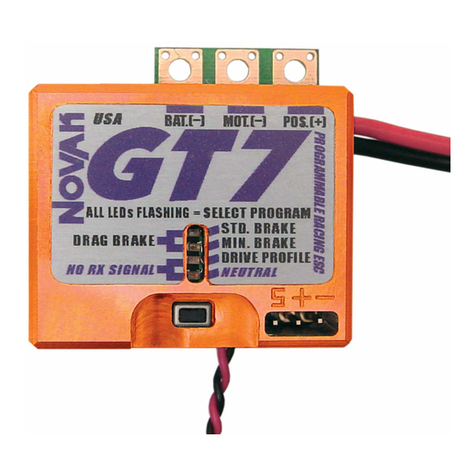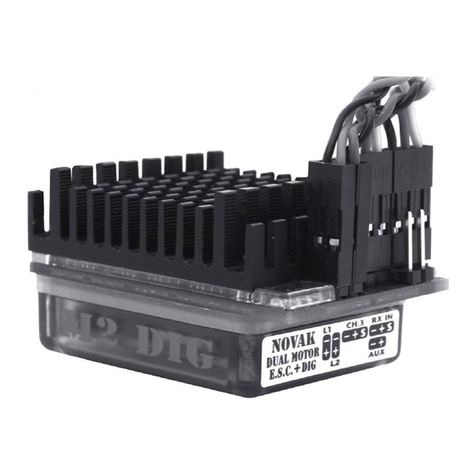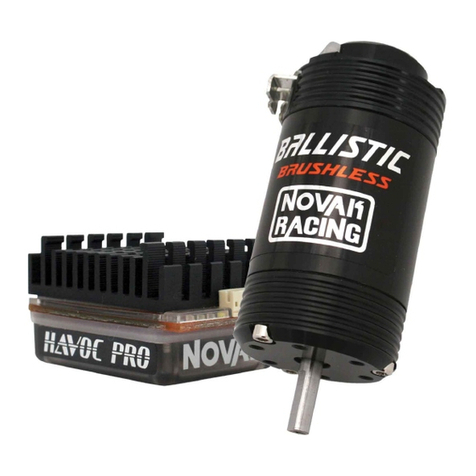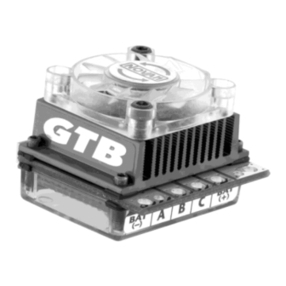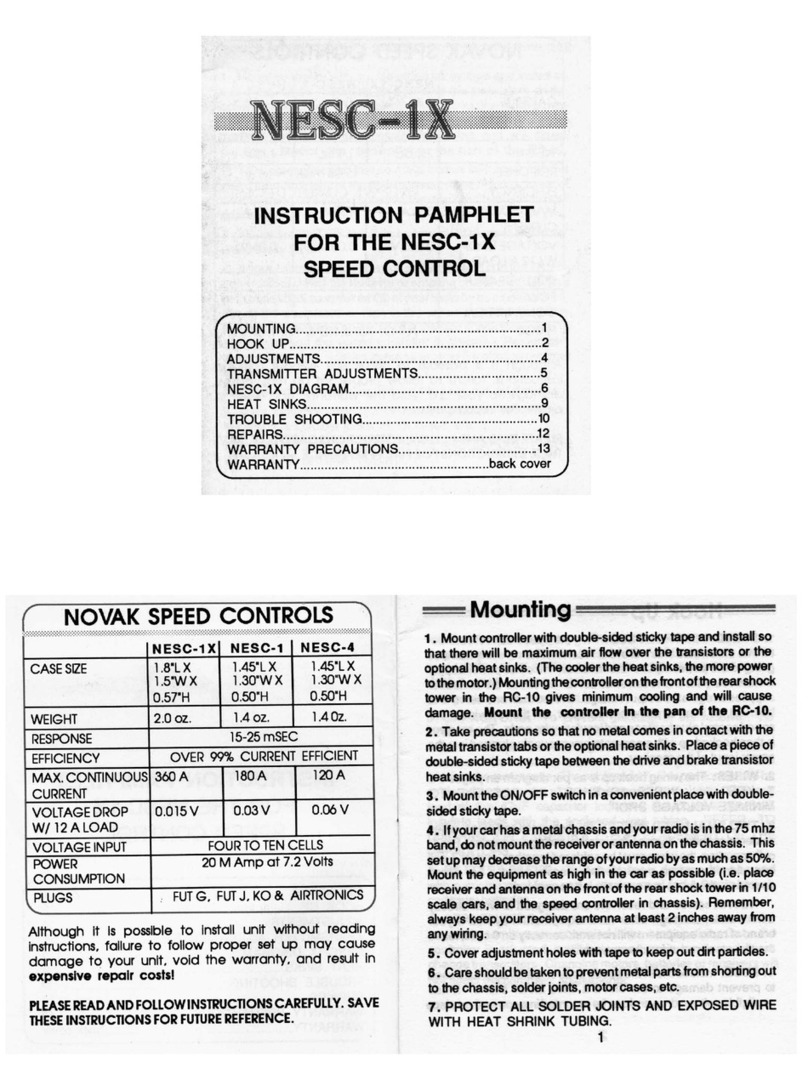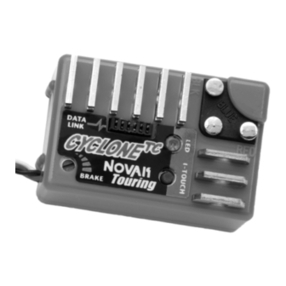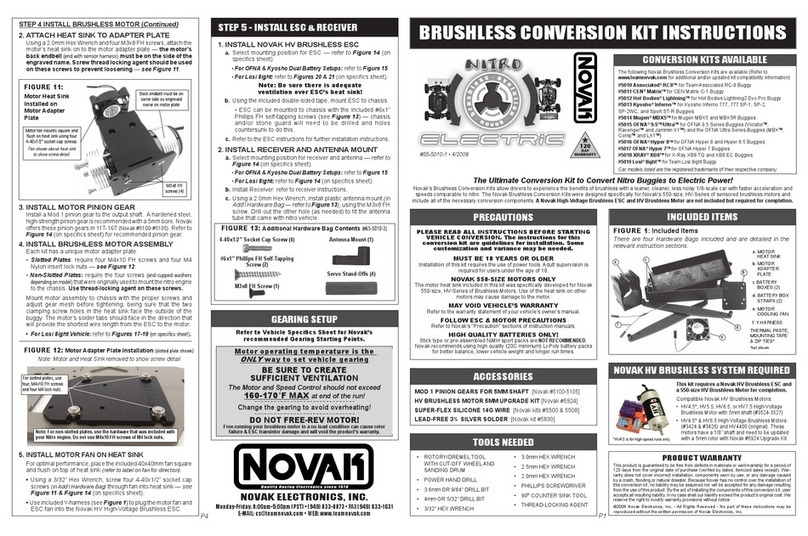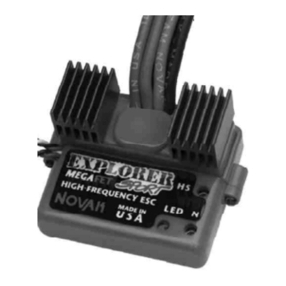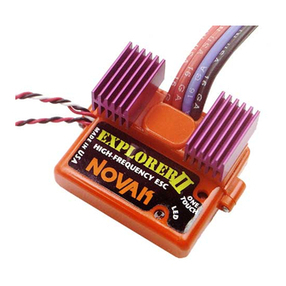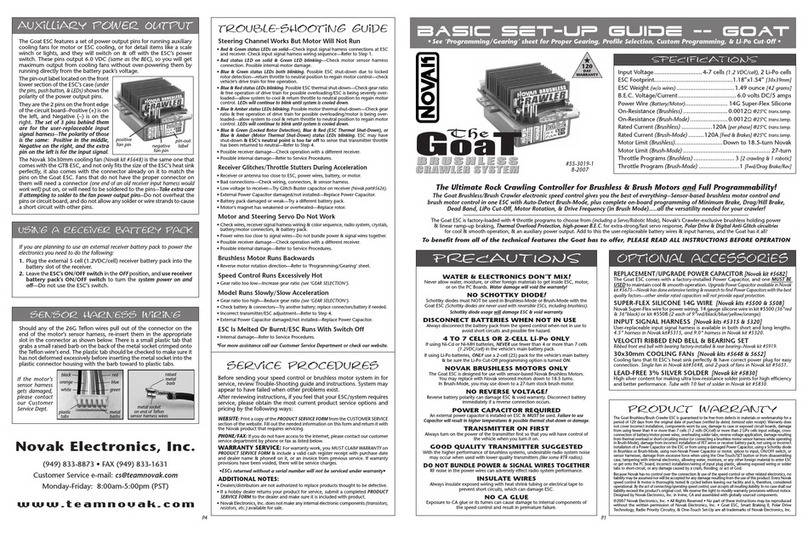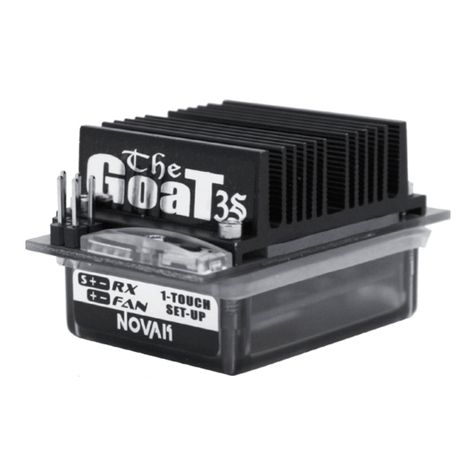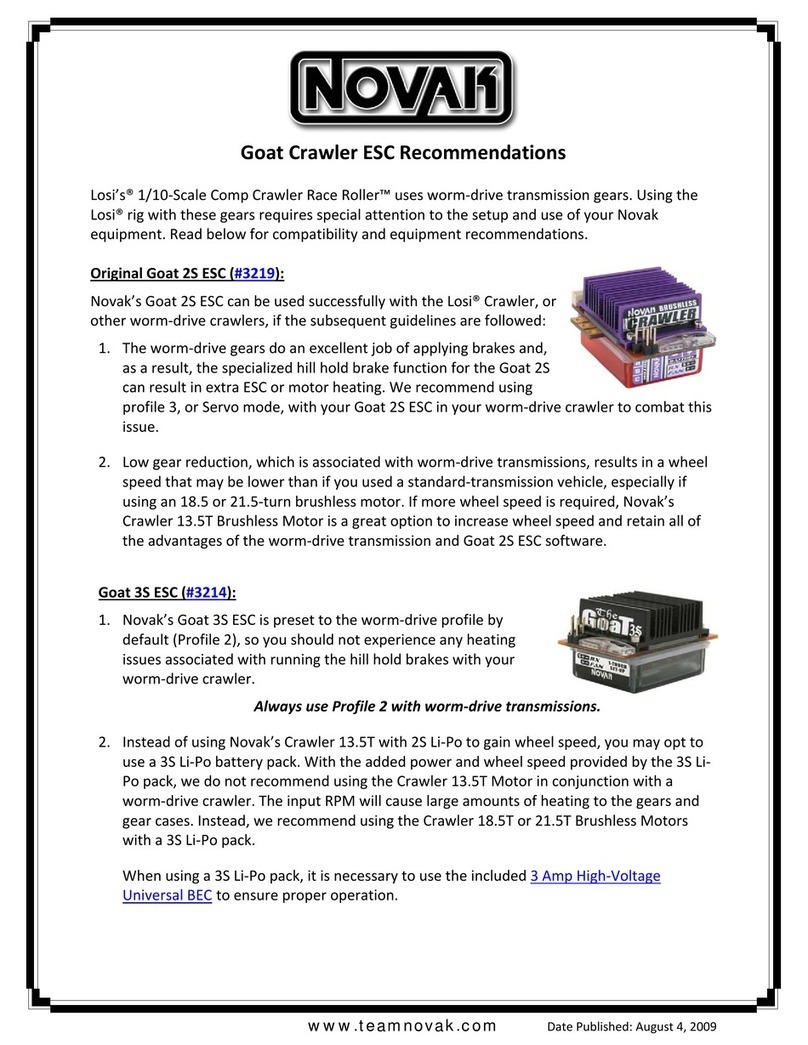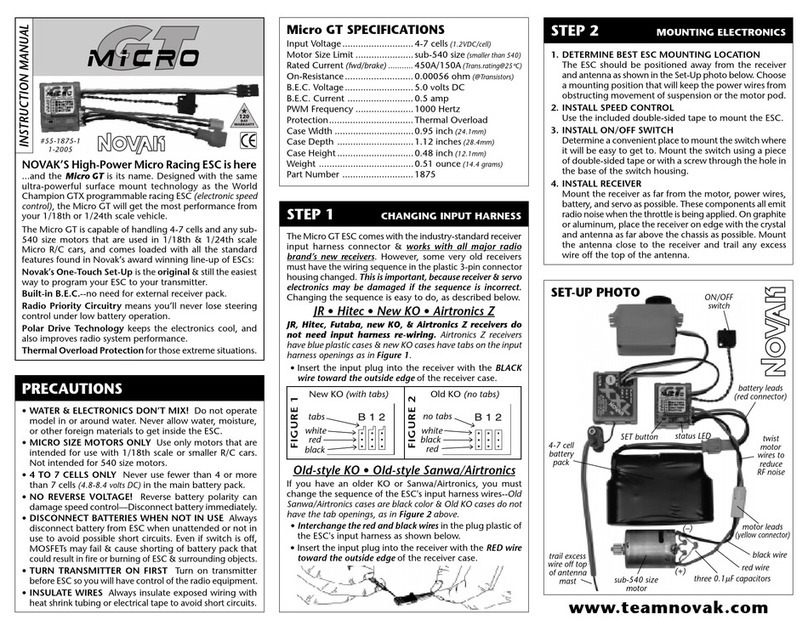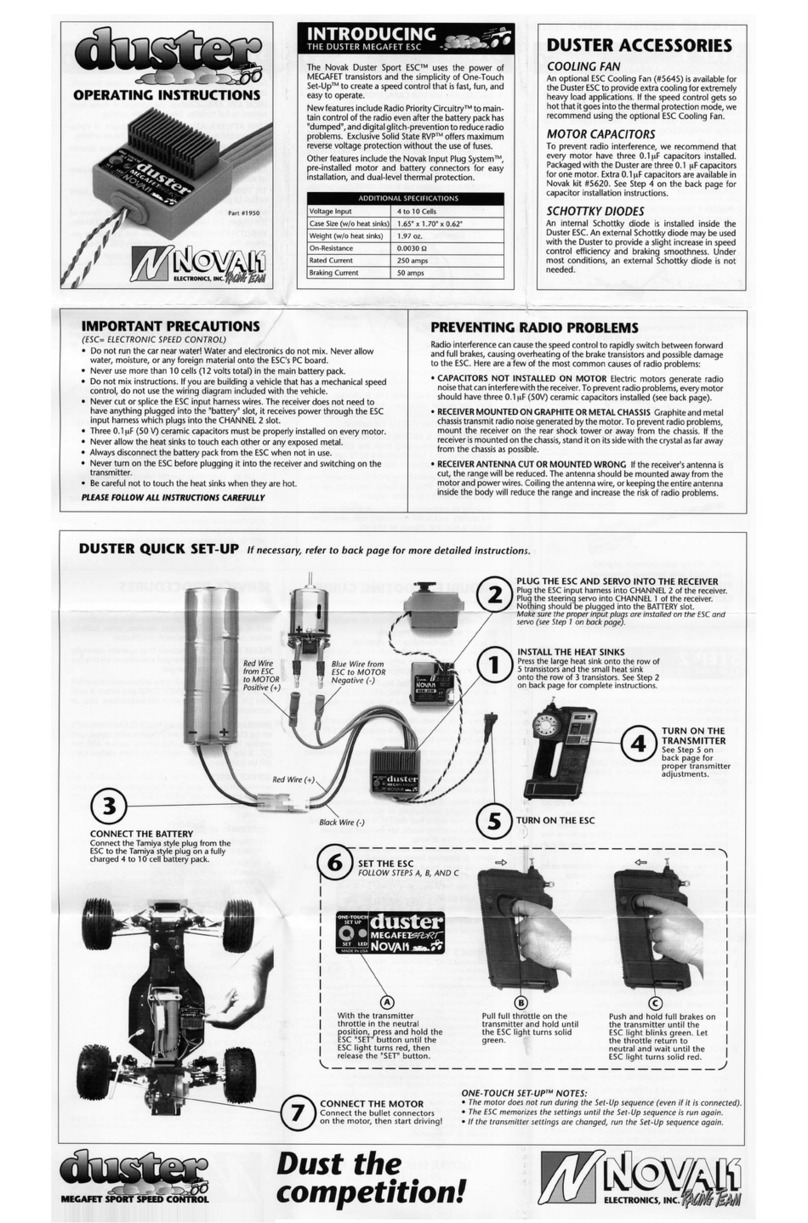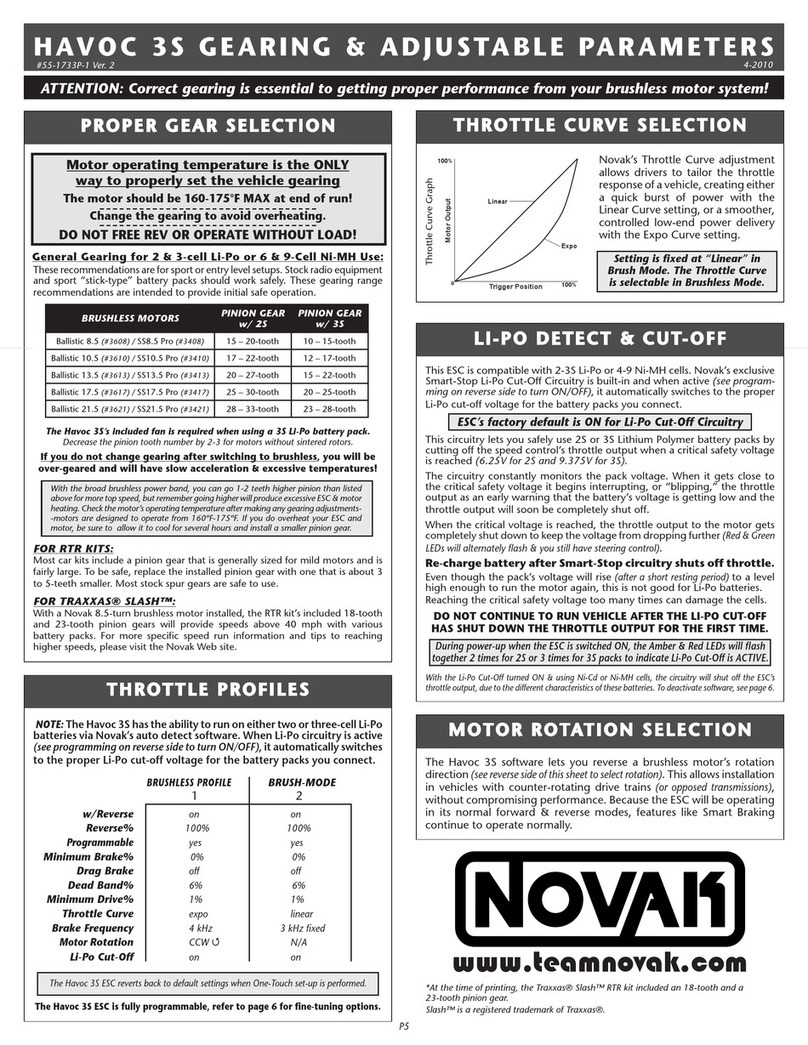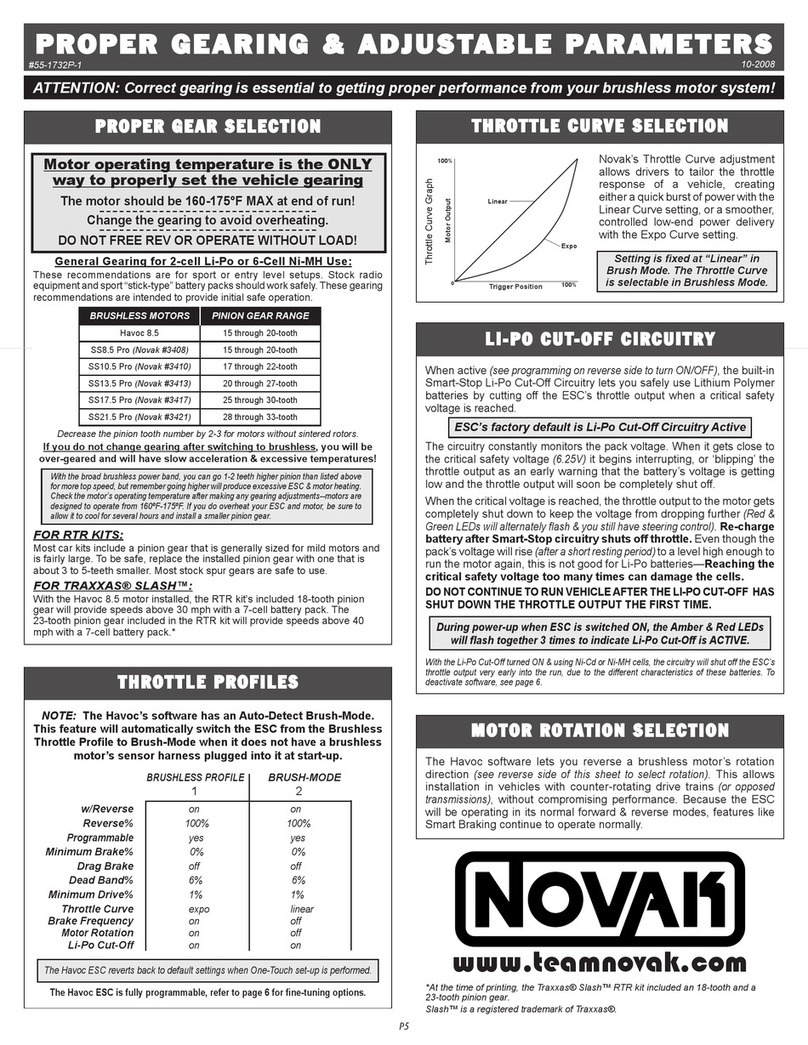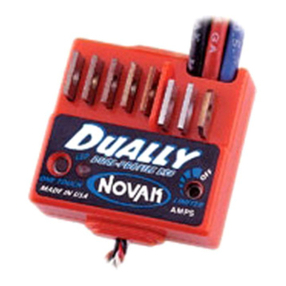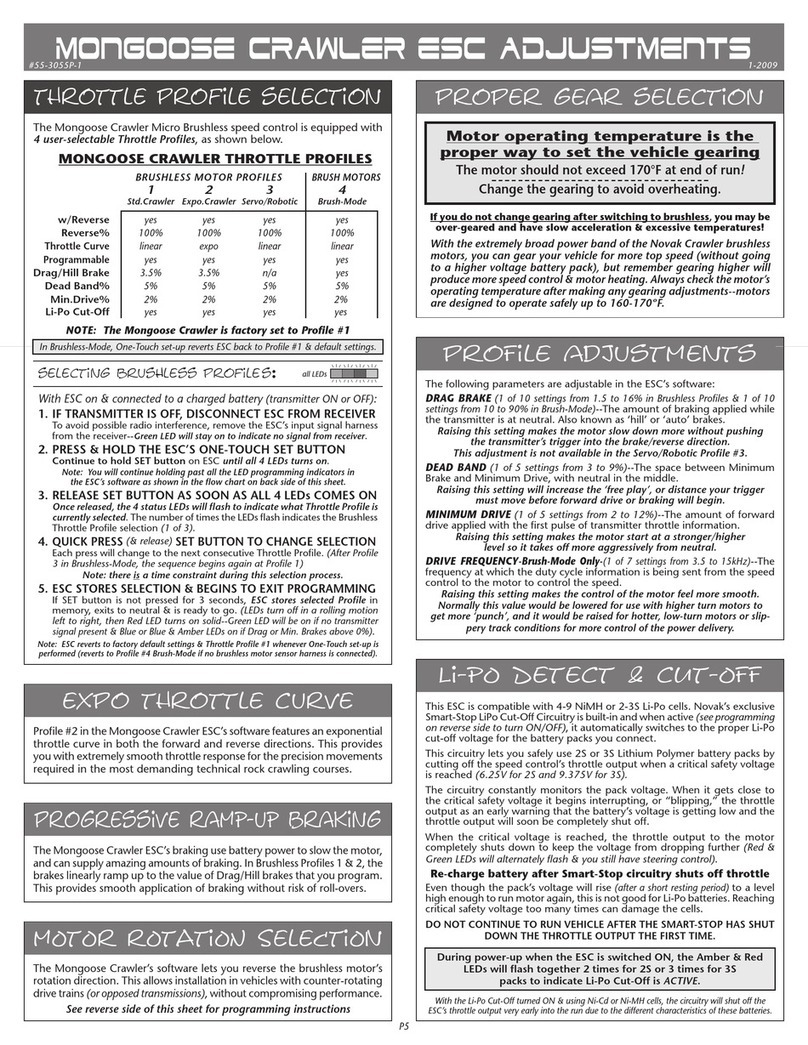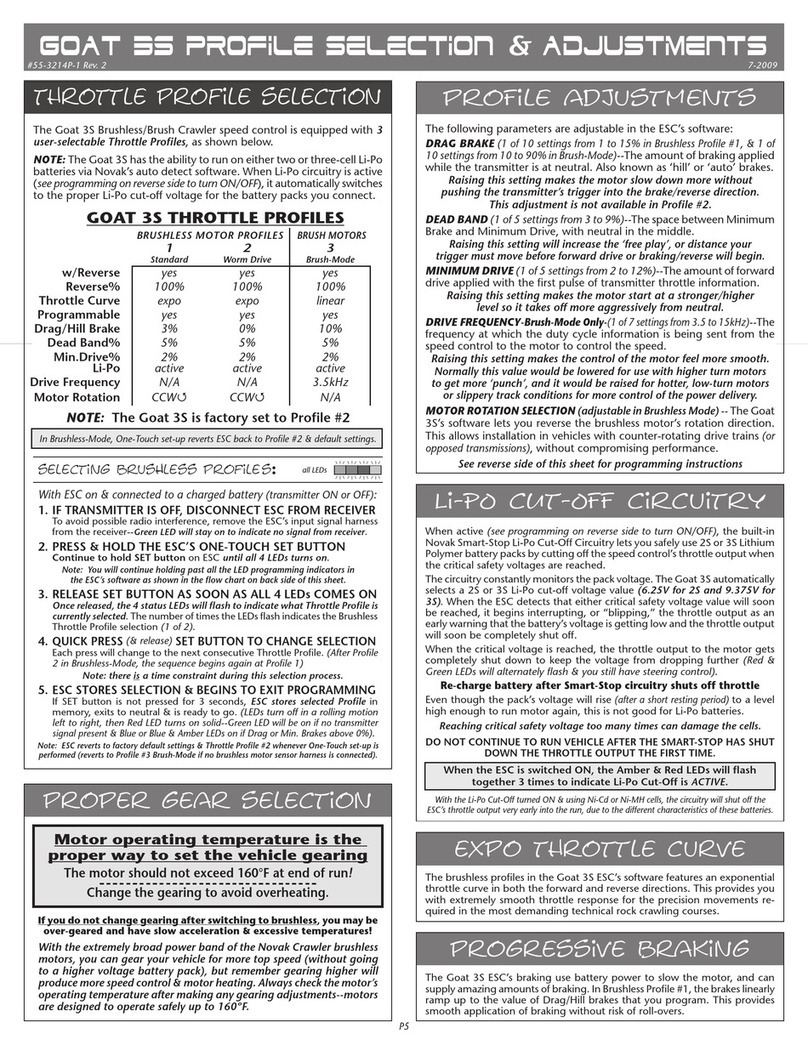#55-3050-1
4-2008
SPECIFICATIONS
Input Voltage.......................... 4-9 cells (1.2 VDC/cell), 2-3 LiPo cells
ESC Footprint.........................................
1.15”x0.95” [29.0x24.3mm]
ESC Weight (w/o wires) ..................................0.77 ounce [22 grams]
B.E.C. Voltage/Current............................... 6.0 volts DC/2.0 amps
Power Wire (Battery/Motor)......................... 16G Super-Flex Silicone
On-Resistance
(Brushless)
................0.0038Ω/phase
@25°C trans.temp.
On-Resistance
(Brush-Mode)
..........0.00038Ω/phase
@25°C trans.temp.
Rated Current (Brushless)
....................40A
[per phase] @25°C trans.temp.
Rated Current (Brush-Mode)
...........40A
[Fwd & Brakes] @25°C trans.temp.
Motor Limit (Brushless)
.....................any Three-80 Micro Pro Novak
Motor Limit (Brush-Mode)
............................any 380-size or smaller
Throttle Programs
(Brushless)
......................
3
[2 w/Rev. & 1 Fwd/Brake]
Throttle Program
(Brush-Mode)
....................................
1
[Fwd/Brake]
Brushless & Brush Motor Control and Full Programmability!
The Mongoose electronic speed control gives you the best of everything--Sensor-based brushless motor control, world class
brush motor performance with Auto-Detect Brush-Mode, & complete on-board programming of Minimum Drive, Minimum
Brake, Drag Brake, Dead Band, LiPo Cut-Off, Motor Rotation, & Drive Frequency (in Brush Mode).....All in a micro size!
The Mongoose is factory-loaded with 4 throttle programs to choose from
(including a limited reverse mode)
, Novak’s Smart Braking II
(you don’t go into reverse until
you shift into reverse by returning the trigger to neutral and then back to reverse)
, Thermal Overload Protection, high-power B.E.C. for strong/fast servo response, Polar
Drive & Digital Anti-Glitch circuitries for cool & smooth operation, auxilliary fan power output, and Radio Priority circuitry for the ultimate in control, right down
to the end of the charge. Add to this the user-replaceable battery wires, power capacitor, & input harness, and the Mongoose has it all!
To benefit from all of the technical features of the Mongoose, PLEASE READ ALL INSTRUCTIONS BEFORE OPERATION
WATER & ELECTRONICS DON’T MIX!
Never allow water, moisture, or other foreign materials to get inside ESC, motor,
or on the PC Boards. Water damage will void the warranty!
NO SCHOTTKY IN BRUSHLESS-MODE!
Schottky diodes must NOT be used when using ESC in Brushless-Mode (Schottky
diodes are never used with reversible ESCs, including brushless).
Schottky diode usage in Brushless-Mode will damage ESC & void warranty.
DISCONNECT BATTERIES WHEN NOT IN USE
Always disconnect the battery pack from the speed control when not in use to
avoid short circuits and possible fire hazard.
4 TO 9 CELLS OR 2-3 CELL LiPo ONLY
If using Ni-Cd or Ni-MH batteries, NEVER use fewer than 4 or more than 9 cells
(1.2VDC/cell) in the vehicle’s main battery pack.
If using LiPo batteries, ONLY use a 2-cell (2S) or 3-cell (3S) pack for the vehicle’s
main battery & be sure the correct LiPo Cut-Off programming option is turned ON.
NOVAK BRUSHLESS MOTORS ONLY
The Mongoose is designed for use with sensor-based Novak Brushless Motors.
You may replace with any Novak Three-80 Micro Pro sensored motor.
NO REVERSE VOLTAGE!
Reverse battery polarity can damage ESC & void warranty. Disconnect battery
immediately if a reverse connection occurs.
POWER CAPACITOR REQUIRED
An external power capacitor is installed on ESC & MUST be used. Failure to use
Capacitor may result in higher temperatures & possible thermal shut-down or damage.
TRANSMITTER ON FIRST
Always turn on the power of the transmitter first so that you will have control of
the vehicle when you turn it on.
GOOD QUALITY TRANSMITTER SUGGESTED
With the higher performance of brushless systems, undesirable radio system noise
may occur when used with lower quality transmitters (like some RTR radios).
DO NOT BUNDLE POWER & SIGNAL WIRES TOGETHER
RF noise in the power wires can adversely effect radio system performance.
INSULATE WIRES
Always insulate exposed wiring with heat shrink tubing or electrical tape to
prevent short circuits, which can damage ESC.
NO CA GLUE
Exposure to CA glue or its fumes can cause damage to internal components of
the speed control and result in premature failure.
mongoose BASIC SET-UP GUIDE
• See ‘Programming/Gearing’ sheet for Proper Gearing, Profile Selection, Custom Programming, & LiPo Cut-Off •
PRECAuTIONS
optional accessories
P1P4
product warranty
The Mongoose Brushless ESC is guaranteed to be free from defects in materials or workmanship for a period of
120 days from the original date of purchase (verified by dated, itemized sales receipt). Warranty does not cover
incorrect installation, components worn by use, damage to case or exposed circuit boards, damage from using
fewer than 4 or more than 9 cells (1.2 volts DC/cell) or more than 3 LiPo cells input voltage, cross-connection
of battery/
motor power wires, overheating solder tabs, reverse voltage application, damage resulting from
thermal overload
or short-circuiting motor (or connecting a brushless motor sensor harness while operating in
Brush-Mode), damage from incorrect installation of FET servo or receiver battery pack, not using or incorrect
installation of a Power Capacitor on the ESC or from using a damaged Power Capacitor, using a Schottky diode,
using non-Novak Power Capacitor or motor, splices to input, ON/OFF switch, or sensor harnesses, damage from
excessive force when using the One-Touch/SET button or from disassembling case, tampering with internal
electronics, allowing water, moisture, or any other foreign material to enter ESC or get onto the PC board,
incorrect installation/wiring of input plug plastic, allowing exposed wiring or solder tabs to short-circuit, or any
damage caused by a crash, flooding, or act of God.
Because Novak has no control over the connection & use of the speed control or other related electronics, no
liability may be assumed nor will be accepted for any damage resulting from the use of this product. Every Novak
speed control & motor is thoroughly tested & cycled before leaving our facility and is, therefore, considered
operational. By the act of connecting/operating speed control, user accepts all resulting liability. In no case shall our
liability exceed the product’s original cost. We reserve the right to modify warranty provisions without notice.
Designed by Novak Electronics, Inc. in Irvine, CA and assembled with globally sourced components.
©2008 Novak Electronics, Inc. • All Rights Reserved • No part of these instructions may be reproduced
without the written permission of Novak Electronics, Inc. • Mongoose ESC, Smart Braking II, Polar Drive
Technology, Radio Priority Circuitry, & One-Touch Set-Up are all trademarks of Novak Electronics, Inc.
5200 1/8” Mod 0.6 Pinion Gear Set--Anodized aluminum pinion gears (11T, 12T, & 13T).
5201 1/8” Mod 0.6 Pinion Gear Set--Anodized aluminum pinion gears (14T, 15T, & 16T).
5202 1/8” Mod 0.6 Pinion Gear Set--Anodized aluminum pinion gears (17T, 18T, & 19T).
5210 1/8” Mod 0.5 Pinion Gear Set--Anodized aluminum pinion gears (11T, 12T, & 13T).
5211 1/8” Mod 0.5 Pinion Gear Set--Anodized aluminum pinion gears (14T, 15T, & 16T).
5212 1/8” Mod 0.5 Pinion Gear Set--Anodized aluminum pinion gears (17T, 18T, & 19T).
5304 Input Plug Harness--Mini--Replacement Mongoose 2mm-to-JST input signal harness.
5509 16GA Brushless Wire Set--2 pieces each of 9” silicone blue, yellow, orange, black, & red.
5600 ESC Switch Harness--Replacement ON/OFF switch harness for speed controls.
5647 Black Cooling Fan--25x25x10mm--All purpose cooling fan with 2-pin JST connector.
5683 Power Trans-Cap Module--Mongoose--Replacement power capacitor module.
5720 2mm Power Connectors--2 pair--Gold plated low-loss 16-20G power connectors.
5721 2mm Power Connectors--5 pair--Gold plated low-loss 16-20G power connectors.
5722 2mm Power Connectors--12 male--Gold plated low-loss 16-20G power connectors.
5723 2mm Power Connectors--12 female
--Gold plated low-loss
16-20G
power connectors.
5825 Micro Battery Cross Bars--7pcs--Gold plated oxygen-free copper micro battery bars.
5826 Micro Battery Cross Bars--28pcs--Gold plated oxygen-free copper micro battery bars.
5831 Lead-Free 3% Silver Racing Solder--6g--Low-resistance, high-conductivity solder.
5832 Lead-Free 3% Silver Racing Solder--15g--Low-resistance, high-conductivity solder.
5833 Lead-Free 3% Silver Racing Solder--100g--Low-resistance, high-conductivity solder.
5840 Double-Sided Mounting Tape--10pcs--1”x1” high-performance clear mounting tape.
5915 Three-80 Sintered Rotor--Replacement sintered neodymium rotor for Three-80 motors.
5916 Three-80 Front End Bell & Bearings--Replacement front end bell & both bearings.
negative
fan pin
positive
fan pin
trouble-shooting guide
Steering Channel Works But Motor Will Not Run
• LiPo Cut-Off Circuitry acitivated––Disconnect LiPo battery pack and re-charge.
• Red & Green status LEDs on solid––Check input signal harness connections at ESC
and receiver. Check input signal harness wiring sequence––Refer to Step 1.
• Red status LED on solid & Green LED blinking––Check motor sensor harness
connection. Possible internal motor damage.
• Blue & Green status LEDs both blinking. Possible ESC shut-down due to locked
rotor detection––return throttle to neutral position to regain motor control––check
vehicle’s drive train for free operation.
• Blue & Red status LEDs blinking. Possible ESC thermal shut-down––Check gear ratio
& free operation of drive train for possible overloading/ESC is being severely over-
loaded––allow system to cool & return throttle to neutral position to regain motor
control. LEDs will continue to blink until system is cooled down.
• Blue & Amber status LEDs blinking. Possible motor thermal shut-down––Check gear
ratio & free operation of drive train for possible overloading/motor is being over-
loaded––allow system to cool & return throttle to neutral position to regain motor
control. LEDs will continue to blink until system is cooled down.
• Blue & Green (Locked Rotor Detection), Blue & Red (ESC Thermal Shut-Down), or
Blue & Amber (Motor Thermal Shut-Down) status LEDs blinking. ESC may have
shut-down & ESC’s neutral point is too far off to sense that transmitter throttle
has been returned to neutral––Refer to Step 4.
• Possible receiver damage––Check operation with a different receiver.
• Possible internal damage––Refer to Service Procedures.
Throttle Stutters or Receiver Glitches During Acceleration
•
Dead Band too tight––Increase ESC’s Dead Band adjustment
(see Progamming sheet)
.
• Receiver or antenna too close to ESC, power wires, battery, or motor.
• Bad connections––Check wiring, connectors, & sensor harness.
• Low voltage to receiver––Try Glitch Buster capacitor on receiver
(Novak part#5626)
.
• External Power Capacitor damaged/not installed––Replace Power Capacitor.
• Battery pack damaged or weak––Try a different battery pack.
• Motor’s magnet has weakened or overheated––Replace rotor.
Motor and Steering Servo Do Not Work
• Check wires, receiver signal harness wiring & color sequence, radio system, crystals,
battery/motor connectors, & battery pack.
•
Power wires too close to signal wires––Do not bundle power & signal wires together.
• Possible receiver damage––Check operation with a different receiver.
• Possible internal damage––Refer to Service Procedures.
Brushless Motor Runs Backwards
• Reverse motor rotation direction––Refer to ‘Custom Programming’ sheet.
Speed Control Runs Excessively Hot
• Gear ratio too low––Increase gear ratio (see ‘PROPER GEAR SELECTION’ section).
Model Runs Slowly/Slow Acceleration
• Gear ratio too high––Reduce gear ratio (see ‘PROPER GEAR SELECTION’ section).
•
Check battery & connectors
––Try another battery; replace connectors/battery if needed.
• Incorrect transmitter/ESC adjustment––Refer to Step 4.
• External Power Capacitor damaged/not installed––Replace Power Capacitor.
ESC Is Melted Or Burnt/ESC Runs With Switch Off
• Internal damage––Refer to Service Procedures.
*For more assistance call our Customer Service Department or check our website.
service procedures
Before sending your speed control or brushless motor system in for
service, review Trouble-Shooting guide and instructions. System may
appear to have failed when other problems exist.
After reviewing instructions, if you feel that your ESC/system requires
service, please obtain the most current product service options and
pricing by the following ways:
WEBSITE: Print a copy of the PRODUCT SERVICE FORM from the CUSTOMER SERVICE
section of the website. Fill out the needed information on this form and return it with
the Novak product that requires servicing.
PHONE/FAX: If you do not have access to the internet, please contact our customer
service department by phone or fax as listed below.
WARRANTY SERVICE: For warranty work, you MUST CLAIM WARRANTY on
PRODUCT
SERVICE FORM & include a valid cash register receipt with purchase
date
and dealer name & phone# on it, or an invoice from previous service. If warranty
provisions have been voided, there will be service charges.
•ESCs returned without a serial number will not be serviced under warranty•
ADDITIONAL NOTES:
•
Dealers/distributors are not authorized to replace products thought to be defective.
• If a hobby dealer returns your product for service, submit a completed PRODUCT
SERVICE FORM to the dealer and make sure it is included with product.
• Novak Electronics, Inc. does not make any internal electronic components (transistors,
resistors, etc.) available for sale.
using a receiver battery pack
If you are planning to use an external receiver battery pack to power the
electronics you need to do the following:
1. Plug the external 5 cell (1.2VDC/cell) receiver battery pack into the
battery slot of the receiver.
2. Leave the ESC’s ON/OFF switch in the OFF position, and use receiver
battery pack’s ON/OFF switch to turn the system power on and
off––Do not use the ESC’s switch.
AuxiliAry power OUtput
The Mongoose ESC features a set of power output pins for running
auxiliary cooling fans for motor or ESC cooling, or for detail items like
scale lights, and they will switch on & off with the ESC’s power switch.
These pins output 6.0 VDC (same as the BEC), so you will get maximum
output from cooling fans without over-powering them by running
directly from the battery pack’s voltage.
There are the 2 pins on the front
edge of the circuit board--Positive
(+) is on the left, and Negative (–) is
on the right.
The set of 3 pins behind them are
for the user-replaceable input signal
harness--The polarity of those is the
same: Positive in the middle, Negative
on the right, and the extra pin on the
left is for the input signal.
The Novak 25x25mm cooling fan
(Novak kit #5647)
not only fits the size
of the ESC’s heat sink perfectly, it also comes with the connector already
on it to match the pins on the ESC. Fans that do not have the proper
connector on them will need a connector put on
(one end of an old receiver
input harness would work well)
, or will need to be soldered to the pins--
Take
extra care if attempting to solder to the fan power output pins
--Do not
overheat the pins or circuit board, and do not allow any solder or wire
strands to cause a short circuit with other pins.
Novak Electronics, Inc.
17032 Armstrong Avenue
Irvine, CA 92614
(949) 833-8873 • FAX (949) 833-1631
Monday-Friday: 8:00am-5:00pm (PST)
www.teamnovak.com
